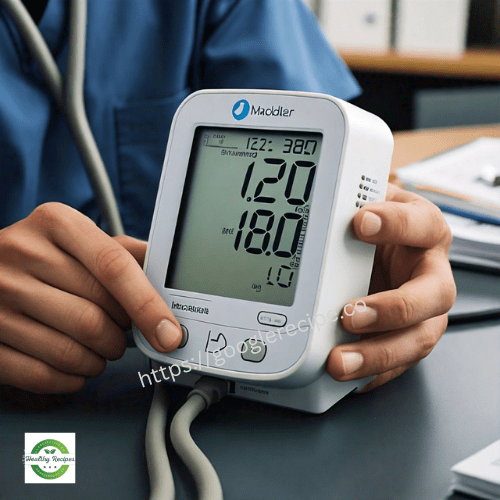Diastolic Blood Pressure
Understanding Diastolic Blood Pressure
Your blood pressure is key to your heart’s health. While systolic blood pressure gets a lot of focus, diastolic pressure is just as vital. It gauges the pressure within your arteries during the intervals between heartbeats. Knowing this part of your blood pressure helps understand your risk for heart disease and stroke.
Diastolic blood pressure shows how healthy your blood vessels are. High diastolic pressure means your arteries are under stress. This may eventually result in major health issues. By keeping an eye on and managing your diastolic blood pressure, you can protect your heart health and lower your risk of serious health issues.
Key Takeaways
- The pressure in your arteries while your heart is at rest is measured by your diastolic blood pressure.
- Understanding diastolic blood pressure is crucial for assessing your overall cardiovascular health.
- Elevated diastolic blood pressure can indicate underlying health concerns and increase your risk of heart disease and stroke.
- Monitoring and managing diastolic blood pressure through lifestyle changes and, if necessary, medication can help improve your heart health.
- Maintaining a healthy diastolic blood pressure range is an important step in preventing and managing cardiovascular diseases.
What is Diastolic Blood Pressure?
Diastolic blood pressure is a key part of the cardiovascular system. It shows the pressure in your blood vessels when your heart rests between beats. Knowing about diastolic blood pressure helps keep your heart healthy and manage heart-related issues.
Definition and Importance
The lower number in a blood pressure reading is diastolic pressure, like the 80 in 120/80 mmHg. It shows the pressure in arteries when the heart fills with blood, right before it pumps. Keeping diastolic pressure healthy is key for good blood flow and avoiding heart disease or stroke.
Relationship with Systolic Pressure
Diastolic pressure works with systolic pressure, the top number in readings. Systolic pressure is the force generated by the heart’s outflow of blood.. A good balance between these pressures is vital for heart health. Knowing how they work together helps understand your heart’s health and any risks.
Normal Diastolic Blood Pressure Ranges
Keeping your diastolic blood pressure in check is key for your heart health. This type of blood pressure measures your artery pressure when your heart rests. It should stay within a normal range for good blood flow and heart function.
Experts say a normal diastolic blood pressure is between 60 and 80 millimeters of mercury (mmHg). This range is important for managing high blood pressure and keeping your heart healthy.
| Blood Pressure Category | Diastolic Blood Pressure (mmHg) |
|---|---|
| Normal | 60-80 mmHg |
| Elevated | 81-89 mmHg |
| Hypertension Stage 1 | 90-99 mmHg |
| Hypertension Stage 2 | 100 mmHg or higher |
Remember, these are general guidelines. Your doctor may suggest different target levels based on your health and other factors. Regular check-ups and talking with your doctor can help keep your blood pressure in check.
Causes of High Diastolic Blood Pressure
Diastolic blood pressure is the force on your blood vessel walls when your heart rests. It can go up for many reasons. Knowing what causes high diastolic blood pressure is key to managing it well.
Lifestyle Factors
Your daily habits can affect your diastolic blood pressure. Some common lifestyle factors that may raise your readings include:
- Excess sodium intake from a diet high in processed and fast foods
- Lack of regular physical activity and a sedentary lifestyle
- Excessive alcohol consumption
- Chronic stress and poor stress management techniques
- Excess weight or obesity
Medical Conditions
Some medical conditions can also cause high diastolic blood pressure. These include:
- Kidney disease or kidney damage
- illnesses of the adrenal glands, such as Cushing’s syndrome and pheochromocytoma
- Thyroid imbalances, both hypo- and hyperthyroidism
- Sleep apnea, a sleep disorder that can disrupt breathing patterns
- Certain medications, including oral contraceptives, decongestants, and some antidepressants
By fixing these lifestyle habits and managing medical conditions, you can help keep your diastolic blood pressure healthy. This lowers your risk of hypertension and other health issues.
Risks of Elevated Diastolic Blood Pressure
Keeping your diastolic blood pressure in check is key for your health. High diastolic blood pressure raises your risk of serious health issues. These include heart disease, stroke, and kidney damage.
High diastolic blood pressure can harm your heart health. It puts extra strain on your heart. This strain can lead to heart disease. It can also cause heart muscle weakness, increase heart attack risk, and lead to severe complications.
High diastolic blood pressure also raises your risk of stroke. It damages or narrows your blood vessels. This makes it hard for blood to reach your brain, leading to stroke. Strokes can result in death, incapacity, or damage to the brain.
Also, high diastolic blood pressure can hurt your kidneys. It damages the blood vessels and filters in your kidneys over time. This can lead to kidney damage and even kidney failure.
It’s important to watch your diastolic blood pressure closely. Taking steps to manage it can lower your risk of these serious conditions. This way, you can live a longer, healthier life.
Diastolic Blood Pressure Readings
Checking your diastolic blood pressure is key for a healthy heart. This pressure is the force on your blood vessels when your heart rests between beats. Knowing how to measure and understand these readings helps you keep an eye on your health.
Measuring at Home
Checking your blood pressure at home is easy and helpful. Here are some tips:
- Use a validated, upper-arm cuff blood pressure monitor.
- Take readings at the same time each day, preferably in the morning and evening.
- Wait five minutes in silence before getting a reading.
- Support your arm at heart level and keep your feet flat on the floor.
- Take multiple readings and record the results to establish a consistent pattern.
Interpreting Results
Understanding your diastolic blood pressure readings is important for your heart health. Here’s a simple guide:
| Diastolic Blood Pressure Range | Interpretation |
|---|---|
| Less than 80 mmHg | Normal |
| 80-89 mmHg | Elevated |
| 90 mmHg or higher | High (Hypertension) |
If your readings often show elevated or high pressure, talk to your doctor. They can help find the cause and plan how to manage it.
Diastolic Blood Pressure Management
Managing high diastolic blood pressure is key for heart health and lowering the risk of serious issues. This means making lifestyle changes and possibly taking medicines as your doctor suggests.
Lifestyle Modifications
Changing your daily habits can really help with diastolic blood pressure. Here are some tips:
- Do at least 30 minutes of physical activity daily, like walking, swimming, or cycling.
- Eat a diet full of fruits, veggies, whole grains, and lean meats, but cut down on salt, fats, and sugars.
- Keep a healthy weight or aim for a good BMI.
- Use relaxation methods like meditation, yoga, or deep breathing to manage stress.
- Drink less alcohol and stop smoking to help control your blood pressure.
Medications
Sometimes, just changing your lifestyle isn’t enough to manage high diastolic blood pressure. Your doctor might suggest medicines, like:
- Diuretics – These help your kidneys get rid of extra fluid, easing the heart’s workload.
- Angiotensin-converting enzyme (ACE) inhibitors – These relax blood vessels and lower blood pressure.
- Angiotensin II receptor blockers (ARBs) – These also help widen blood vessels and lower pressure.
- Calcium channel blockers – These stop calcium from entering heart and blood vessel cells, relaxing them and lowering pressure.
It’s crucial to work with your healthcare provider to find the right medicine or mix of medicines for you. Always keep an eye on your diastolic blood pressure while taking these treatments.
Monitoring and Tracking Diastolic Blood Pressure
Keeping an eye on your diastolic blood pressure is key for good heart health. This type of blood pressure measures your artery pressure when your heart rests. By tracking these readings, you can spot trends and act early if something’s off.
Using a home blood pressure monitor is a great way to check your diastolic pressure. These devices are simple to use and let you track your readings at home. Keeping a log of these measurements helps you see patterns and changes over time.
It’s also vital to share your blood pressure numbers with your doctor. They can look at the trends and suggest changes to keep your blood pressure healthy. Working with your healthcare team helps keep your heart health in focus.
| Monitoring Diastolic Blood Pressure | Tracking Trends |
|---|---|
|
|
Putting effort into monitoring and tracking your diastolic blood pressure is key for heart health. This helps you and your doctor spot and manage any issues early. It’s a way to support your overall health and well-being.
Preventing High Diastolic Blood Pressure
Keeping your diastolic blood pressure healthy is key for your heart’s health. By focusing on what raises it, you can lower your risk of heart disease. Here are ways to stop high diastolic blood pressure before it starts:
Live a heart-healthy life. Do exercises like walking, jogging, or cycling for 30 minutes daily, often. Consume a diet rich in whole grains, fruits, vegetables, and lean meats. Cut down on sodium, saturated fats, and sugars. Use relaxation methods, mindfulness, or fun hobbies to keep stress low.
Keep a healthy weight. Being overweight can raise your diastolic blood pressure. If you’re heavy, work with your doctor on a plan to lose weight. This plan should include changing your diet and exercising more. Losing a few pounds can really help your diastolic blood pressure.
FAQ about Diastolic Blood Pressure
What is diastolic blood pressure?
Diastolic blood pressure is the pressure in your blood vessels when your heart rests between beats. It is the blood pressure reading’s lowest number.
Why is diastolic blood pressure important?
It’s key to your heart health. It shows how healthy your arteries are. This helps figure out your risk for heart disease and stroke.
What range of values for diastolic blood pressure is considered normal?
A normal range is between 60-80 mmHg. If it’s above 80 mmHg, you might have high blood pressure and need to see a doctor.
What can cause high diastolic blood pressure?
High blood pressure can come from lifestyle choices like eating poorly, not exercising, and drinking too much alcohol. It can also be caused by health issues like kidney disease, thyroid problems, and hormonal imbalances.
What dangers come with elevated diastolic blood pressure?
High pressure can lead to serious health issues. Heart disease, stroke, renal damage, and visual issues are a few of them. Keeping an eye on your pressure is crucial for heart health.
How can I measure my diastolic blood pressure at home?
Use a reliable monitor and follow the instructions. Sit quietly before taking the reading. Take note of the outcomes to monitor changes over time.
How can I lower my diastolic blood pressure?
Make healthy lifestyle changes. Eat well, exercise regularly, manage stress, and cut down on alcohol and tobacco. Your doctor might suggest medication if needed.
Why is it important to monitor my diastolic blood pressure?
Checking your pressure regularly helps spot trends or changes. This lets you and your doctor take action to keep your heart healthy and lower health risks.
What steps can I take to prevent high diastolic blood pressure?
Keep a healthy lifestyle with a good diet, exercise, managing your weight, and reducing stress. Avoid too much alcohol and quit smoking to prevent high blood pressure.


